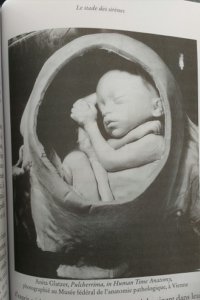
The primordial sphere
Peter Sloterdijk’s surprising book Sphere I among many new  concepts, brings in Chapter 7, entitled “The Sirens Stage: About the first sonospheric alliance”, from page 433 to 470, but the tours are equally interesting, a treatise on original relationship with life, with the Other and with psychology around the issue.
concepts, brings in Chapter 7, entitled “The Sirens Stage: About the first sonospheric alliance”, from page 433 to 470, but the tours are equally interesting, a treatise on original relationship with life, with the Other and with psychology around the issue.
It makes a fundamental analogy with the social sciences: “psychology can cultivate its research on the twins, and the social sciences can pursue its chimera, the homo sociologicus; but for the philosophically reformed science of man, it is peer research and the theory of dual space that are fundamental. Even what recent philosophers have called human existence should no longer be understood as the exit of the lonely individual into an open indeterminate space, nor as the private stay of the mortal in nothing ”(page 433-434), and here his relationship with the death that has been themed this week.
Before talking about reciprocity and dual tension between individuals, ask an essential question about resonance to develop your “sonospheric alliance”, quote Socrates to talk about inner resonance thanks to which “Socrates hears your demon intervene dissuasively in his conversations with himself ? ” (p. 435), but he will also speak of the “attentive, so-called immaculate reciprocity, which allows the Angel of the Annunciation – which most often appears on the left side – to say the impossible to Mary’s ears without her resignation becoming a refusal ? ” (page 435), and below it will say “the inner listening is always linked to a change of attitude, passing from a one-dimensional hearing attentive to the alarm and from a distance, to an overfly hearing, apprehended in a polymorphic way” (idem).
It misses the texts of Ulysses of Odyssey (we have already done a historical comparison with the Ulysses of James Joyce in a post), it will sweep the lines and songs, going through icons, sacred books, texts by patriarchs, hymns and classics “in which” we recognize cultural potentials that have survived ”(p. 436), certainly from where he also got his“ mermaid stage ”from the chapter title, he will make a fair and long analysis of the Odyssey as “resonance ” developing some of his Cantos.
The central point of this chapter is of the most subtle resonance games ”(page 462), to say that there resides what is its original resonance, and states that what“ we call the soul is, at its most sensitive core, a resonance system exercised during communication audio-vocal of the mother-child prenatal sphere ”(page 462), there is developed the primordial relationship with the Other.
“When the future mother speaks to the interior, she enters the primitive scene of free communication with the Other interior” (idem), where “the brightness of the mother’s voice, well before it reappears in her eyes, prepares the child for its reception in the world; it is only by listening to the most intimate greeting that she can agree with the insurmountable advantage of being herself ”(idem), it is this intimacy“ in her first exercise, it is a transference relationship ”(idem).
And “her model is not the learned by the symmetrical alliance of the twins, individuals of identical opinions … but by the inexorably asymmetrical communion between the maternal voice and the fetal ear ”(page 463) (in n the image of Anita Flatzer, Ulcherrima, from Human Time Anatomy. photographed from the Federal Museum of Pathological Anatomy, Vienna) (in book pag. 467).
Thus, the search for the twin, for symmetrical or even identical opinions is not a relationship, neither as the intimate world that already involves the relationship with the Other, nor with the different, asymmetrical and even hostile external world, it is a relationship “since always outside -de-si-em-si: the voice that greets, when addressing this intimate co-listener ”(p. 463), even though Sloteridjk is a thinker for whom religions do not even exist, I would say that it is a high text spirituality.
It states, at this point, that I consider it practically central about “listening to the other”, that when speaking of the primordial fetal relationship, it sees it as the one where “there is no trace of narcissism in this relationship, no illegitimate enjoyment of oneself for a deceptive short -circuit in the relationship with yourself. What distinguishes this relationship is an almost unlimited delivery from each other, as well as the fact that the two sources of stimulus intersect almost without any fissures” (page 463).
The relationship of war, of the almost exclusion of the Other, are the reflexes of an extreme individualism, of enjoyment at the expense of the Other, and even of his life, which the pandemic could lead to an intransigent defense of life seems to be placed at the other extreme, the elimination of the Other, the different and the fragile.
SLOTERDIJK, Peter. (2016) Esferas I: bolhas (José Oscar de Almeida Marques, Trad.). São Paulo: Estação Liberdade.









